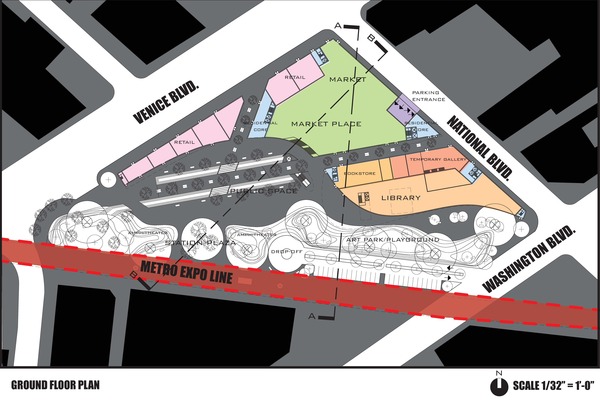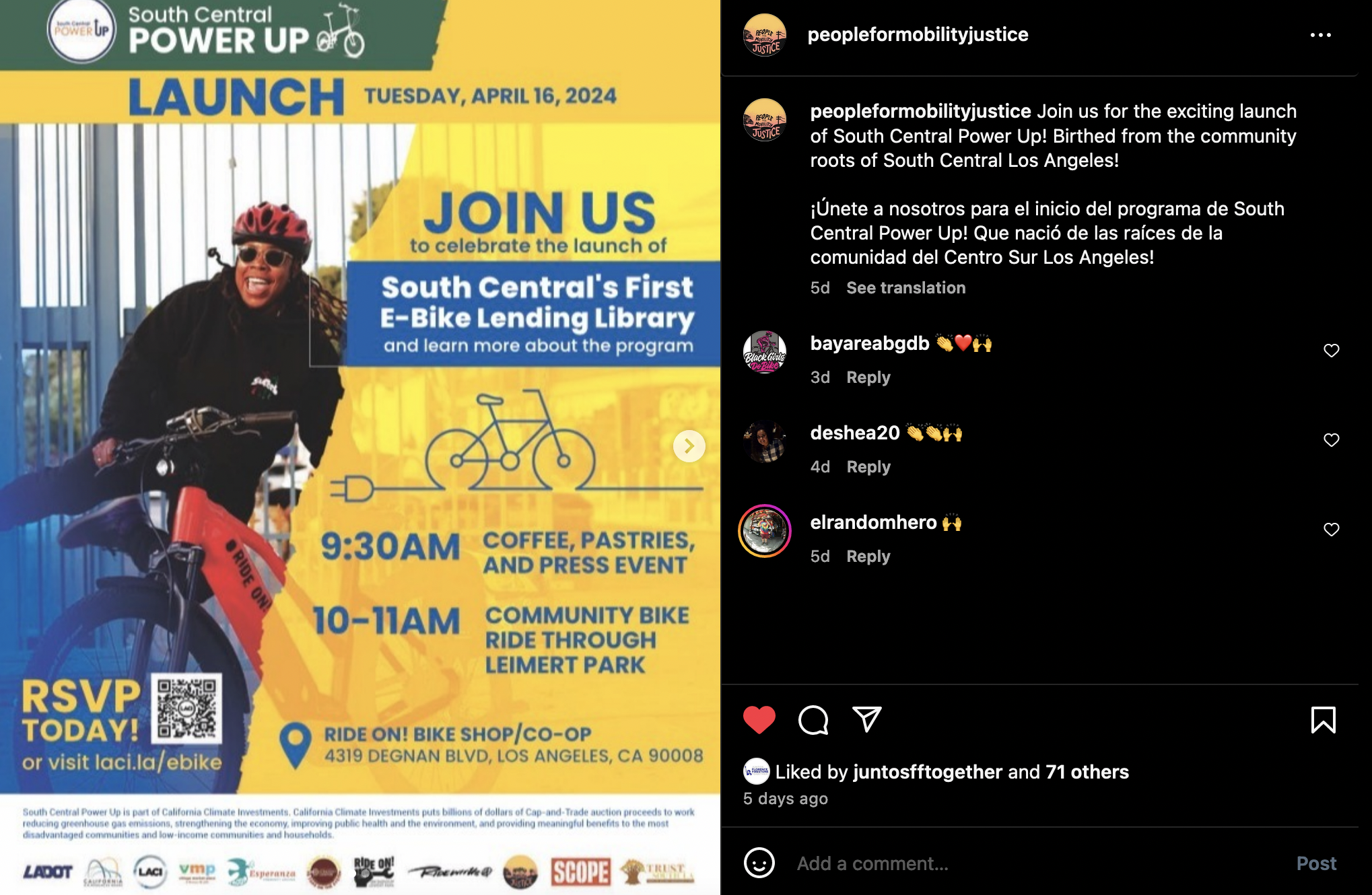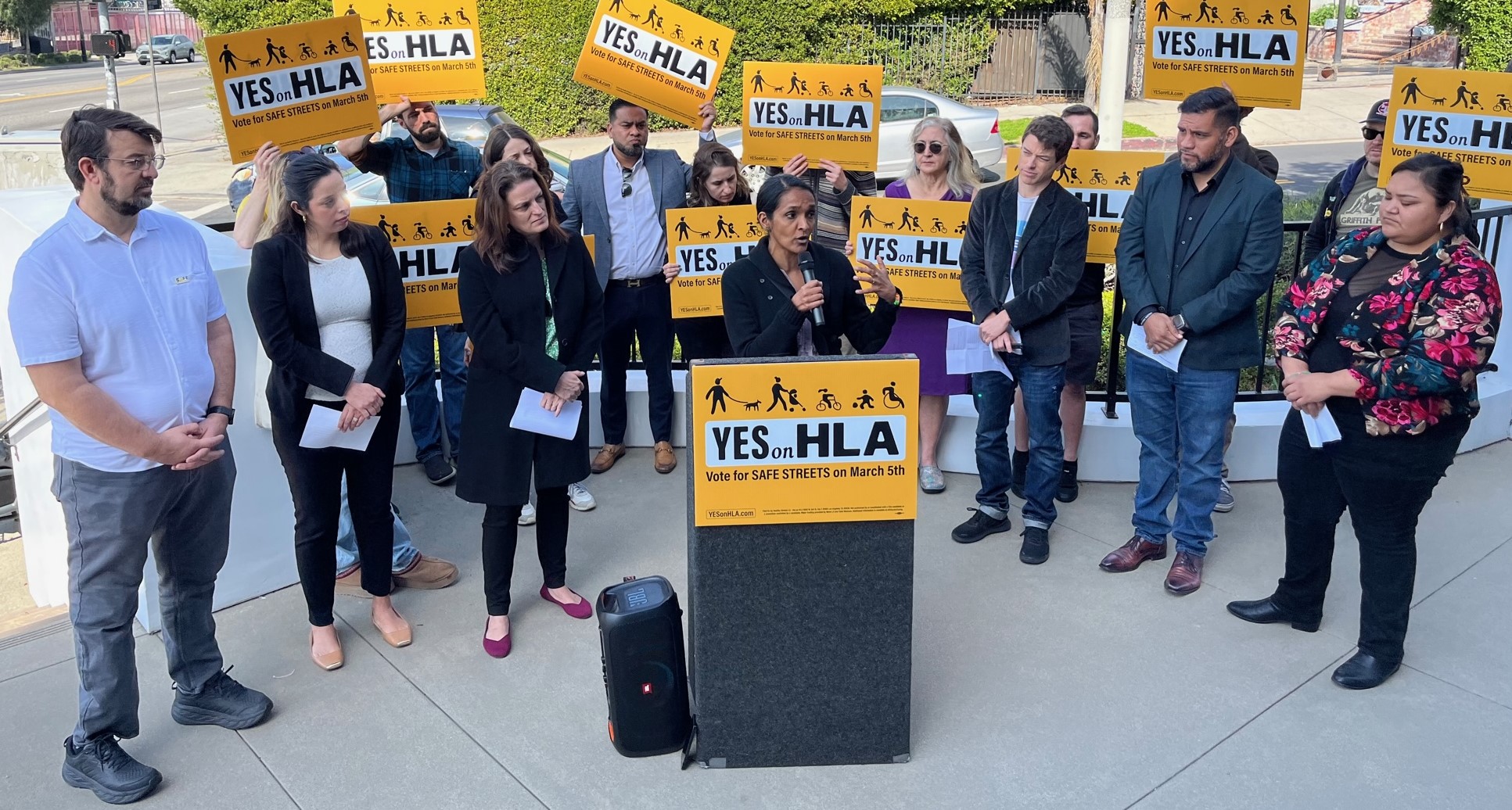Los Angeles and the Case for Transit Oriented Development: Building and Funding TOD
10:31 AM PDT on May 25, 2012

This is the third part of a three part series on Transit Oriented Development written by Joel Epstein. Part I ran on Wednesday and introduced the series and looked at Metro's current role. Part II ran yesterday and focused on the TOD history of L.A. since construction of the Red Line. The series was originally assigned to Joel when he wrote for Metro's website, The Source. There was no effort from Metro to "place" the story with Streetsblog.
Building transit and TODs where it is feasible
In an ideal world, Metro would go out and buy all the land it needs to build lines along the routes where urban density is the greatest. But L.A. long ago ceased to be a city where there is ample undeveloped land and little opposition from residents, business owners and drivers to needed transit improvements.
A case in point is traffic-snarled Santa Monica Boulevard through West Hollywood, Beverly Hills and West L.A. Looking at it today, the reconstructed trunk road, along which a Pacific Electric Railway streetcar once ran, appears to be a sorely missed opportunity to build transit and TODs along the boulevard. But the idea of asking West Hollywood to give up its tree-lined median or Beverly Hills, its parking lots serving South Santa Monica Blvd merchants, underscores the challenge Metro faces in L.A.’s built environment.
TOD planning grants
One initiative Metro is pursuing to improve transit’s chances is its Local Planning Grant Program. The new effort is a competitive grant program designed to promote TOD development by encouraging communities to enact TOD-friendly building codes and regulations. The grants provide the winning communities with funds to go out and look at parking codes, last mile connections (how people get from the rail station or bus stop to their home), greater density around transit and better bike and pedestrian linkages to the rail and bus system.
There are also new requirements in the Federal Transportation Administration’s (FTA) New Starts program that require transit agency applicants for federal funding to look at the impact of their projects on development and make changes that promote TOD.
To date, Metro has given out a total of $5 million in TOD grants. Recipients include Duarte for the Foothill portion of the Gold Line extension, Culver City for Expo Phase 1 and 2, Inglewood for the Crenshaw Line and L.A. for 10 stations within the Expo planning area. Metro will soon be going to the Metro Board with recommendations for another $1 million in grants. Though at this point the program is only a pilot, it may become an ongoing Metro program.
Locally, it is not just Metro that is demonstrating increased interest in TOD. In ways not seen in decades or perhaps ever, TOD and transit are now on the minds and lips of many policy makers and ordinary citizens. A recent article entitled, “Reinventing Los Angeles: Seizing the Transit Opportunity,” by Ken Bernstein in The Planning Report lays out current TOD opportunities and explains the history of TOD in Los Angeles.
According to Bernstein, a Principal City Planner for L.A., “Every half century or so, Los Angeles reinvents itself around its transportation system. In the early 20th century, an extensive streetcar system focused energy in downtown Los Angeles and led to development of streetcar suburbs throughout the city. In the post-World War II era, the freeway system fostered large-scale suburbanization, cementing Los Angeles’ image as a city of “sprawl.” Today, an unprecedented investment in transit, through the 2008 passage of Measure R, a half-cent sales tax, gives Los Angeles the opportunity to reinvent itself once again.”
Within the Planning Department, a “Policy Planning team is organizing most of its work around the opportunities presented by Measure R – to move Los Angeles away from its single-minded focus on the automobile, and to reshape our communities near major transit stations.”
When the first of the Planning Department’s New Community Plans, The Hollywood Plan, came out in December, some critics assailed it as promoting the “Manhattanization” of Hollywood. But, as tend to happen when new ideas are introduced, these fears were greatly exaggerated. Explains Bernstein, “While the Plan does include targeted incentives for mixed-use development around subway stations, the majority of such development is anticipated to be 5-8 stories in height. The Plan contains new height limit provisions for much of central Hollywood, limiting sites for future high-rise development to those existing areas already without height limits, generally along the Vine Street corridor.” Ample protections for existing open space, limits on hillside development, support for a park over the 101 Freeway and preservation of historic Hollywood buildings are also included in the plan.
In 2012, the public will get a chance to consider several Transit-Oriented Specific Plans as they go through the public approvals process. These proposals include a revised Warner Center Specific Plan for the Orange Line-served San Fernando Valley, a new Cornfield Arroyo Seco Specific Plan for the area northeast of downtown, and the Jordan Downs Specific Plan for Watts. The Watts plan, developed in partnership with the City’s Housing Authority, aims to improve access to the 103rd St. Blue Line station.
Reducing Angelenos’ dependence on their cars is also the aim of the new Mobility Element in the City’s General Plan. When it is completed in 2014, the Mobility Element will emphasize transit- and TOD-promoting policies. If this comes to pass, L.A.’s 6,500 miles of streets will be better suited to pedestrians, transit riders, and bicyclists, as well as drivers.
Next stop, Crenshaw
With challenges to TOD in mind, and the Crenshaw Line one of the next projects out of the Metro gate, I spoke with Dan Rosenfeld, Transportation Deputy for Metro Board member and Supervisor Mark Ridley-Thomas.
As a former developer, Rosenfeld knows TOD from both the Metro and developer perspective. When we spoke, he began by praising Metro’s Planning Department for the $5 million it made available through the TOD grant competition, and adds, “In the normal scheme of things the cities should say thanks for building the lines, we’ll take it from here.” Still, Rosenfeld also had praise for the City Planning Department’s master plan for the Crenshaw Corridor. “It was very modest, not proposing projects like the Del Mar and Wilshire/Western projects. The neighborhood reps liked it, with its 45’ foot height limits and traditional parking ratios.”
Metro, Rosenfeld notes, has also entered into some win-win agreements with South L.A. faith based organizations along the Expo Line. For example, at Expo and Crenshaw, the agency worked out an agreement with the West Angeles Church of God in Christ (WACOGIC) Economic Development Corporation to have the church provide 500 parking spaces for weekday commuters using the Crenshaw Expo station. Supervisor Ridley-Thomas’ transportation deputy contrasts this positive with the lack of enthusiasm he feels for the parking lot the Expo Line Construction Authority built at La Brea and Exposition, adjacent to the La Brea Expo station.
In Crenshaw, explains Rosenfeld, people are starting to feel out the relationship with Metro. He expects that on Martin Luther King Jr. Blvd and Crenshaw and in downtown Inglewood there will be TOD proposals and projects as hoped for in Measure R.
What Metro achieves in terms of TOD along the Crenshaw Line will be watched both locally and nationally. Call it economics, redlining, a history of de jure segregation, or some combination of all of the above. Not all parts of the city and station locations are created equal when it comes to their appeal to developers.
Lessons learned
“Making TOD work in LA doesn’t take one executive directive, one City Council motion, or one Metro board approval—it takes thousands of distinct actions. From complete streets to affordable housing, every action feeds into a larger vision of what LA can look like. That is why I convened a cabinet of representatives from City departments and some of the best brains in the business to coordinate those actions in a way that make sense for our City.” - Antonio Villaraigosa
Speaking recently at a Los Angeles conference focused on America Fast Forward and Measure R, Former Vancouver City Council member Gordon Price made the case that cities should create entire transit-oriented districts that cover several square miles. Rather than think of TODs as just a new apartment or condo complex built adjacent to a transit stop, Price argues for complete streets districts with wide, pedestrian-friendly sidewalks, bike lanes, cars lanes and public transit so frequent residents can rely on a bus or train arriving every few minutes.
While L.A. remains far from that vision, the city has come a long way, both transit- and TOD-wise since the Blue Line started rolling 22 years ago. Unlike two decades ago, buyers and renters today who want to live near a rail station have numerous opportunities to do so in places such as Claremont, Fullerton, North Hollywood, South Pasadena, Pasadena, Santa Clarita, and soon, Exposition Park, Mid City and Culver City as well.
The economy and the real estate market are recovering from the most serious shock to their systems in three quarters of a century. This makes it an exciting time at Metro and the city in general. Given the opportunity, the time is now for agency and city officials to demonstrate they are true leaders worthy of the public trust, rather than the inept bureaucrats some armchair critics see them as.
While the fact remains that Metro is first and foremost a transit agency, its role in promoting and partnering to build TODs is well established. This reality will only help L.A. continue down the track to a more transit-oriented city.
Joel Epstein is Chief Talent Officer for bliss lawyers, a new legal model combining the benefits of secondment and virtual law firms. Joel writes frequently on public transit and urban life.
Stay in touch
Sign up for our free newsletter
More from Streetsblog Los Angeles
Metro Looks to Approve Torrance C Line Extension Alignment
Selecting the relatively low-cost hybrid alternative should help the oft-delayed South Bay C Line extension move a step closer to reality
This Week In Livable Streets
CicLAvia returns to Venice Boulevard, Metro board committees, L.A. City Council Transportation Committee, Metro budget theater, and more




